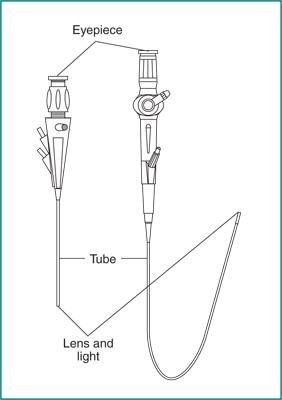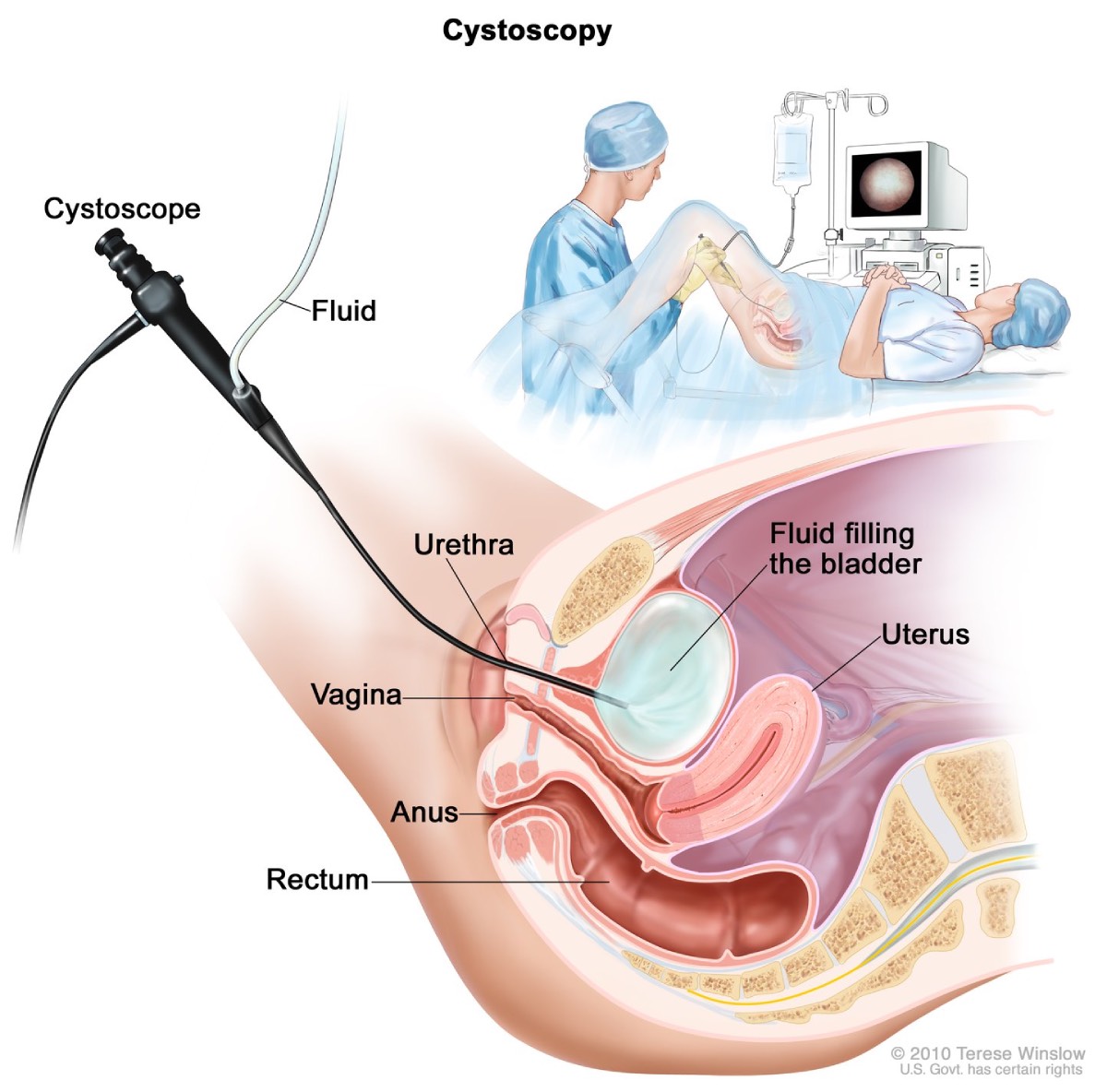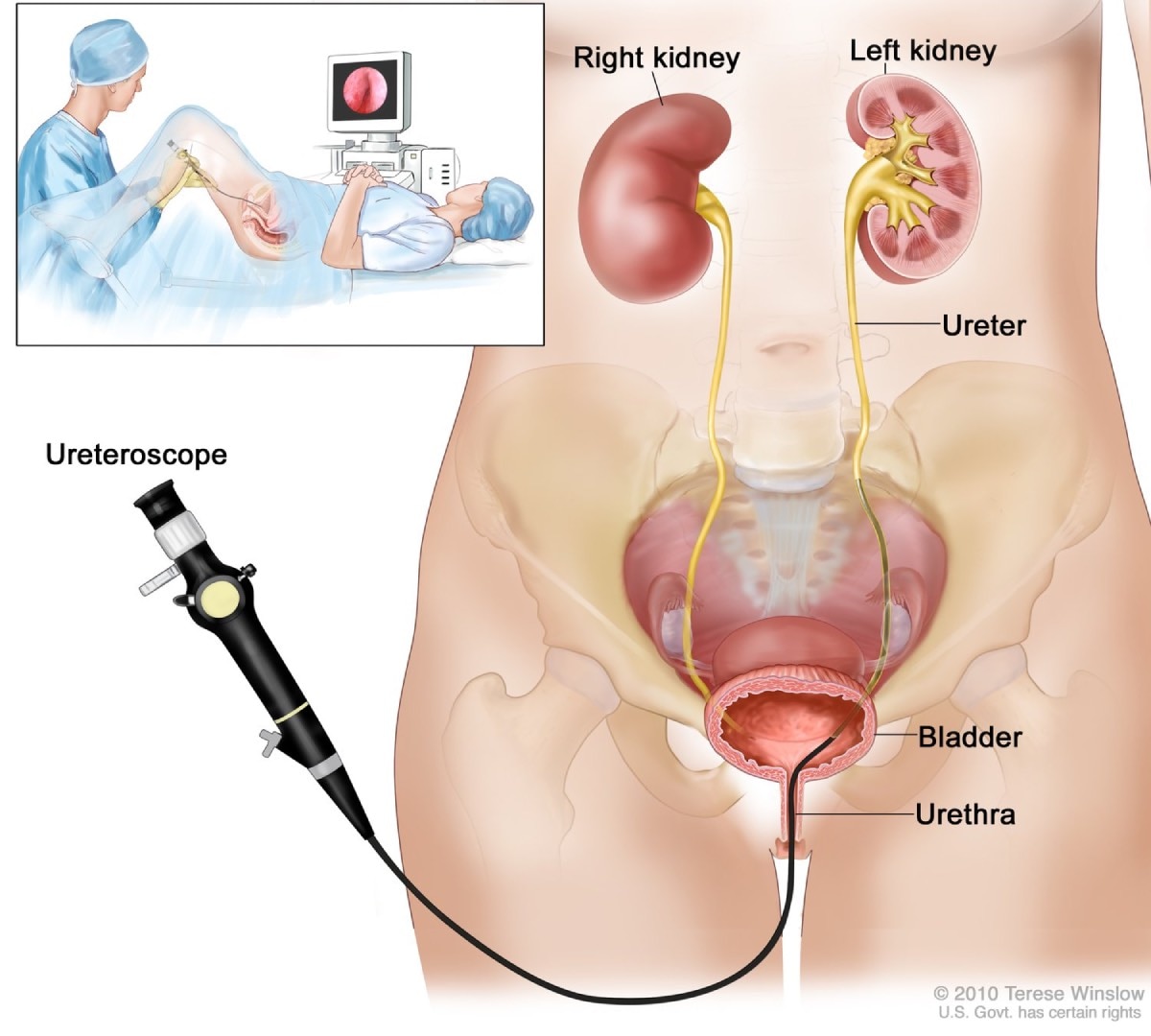Visual Examination Of The Bladder:
On this page:
- What are cystoscopy and ureteroscopy?
- Why do health care professionals perform cystoscopy?
- Why do health care professionals perform ureteroscopy?
- How practise I prepare for a cystoscopy or ureteroscopy?
- How do wellness care professionals perform cystoscopy or ureteroscopy?
- What should I expect after a cystoscopy or ureteroscopy?
- What are the risks of cystoscopy and ureteroscopy?
What are cystoscopy and ureteroscopy?
Cystoscopy and ureteroscopy are common procedures performed by a urologist to look inside the urinary tract.
Cystoscopy is a procedure that uses a cystoscope to look inside the urethra and bladder. A cystoscope is a long, thin optical musical instrument with an eyepiece at i stop, a rigid or flexible tube in the eye, and a tiny lens and light at the other end of the tube. A urologist fills the bladder with fluid and looks at detailed images of the urethra and float linings on a figurer monitor.
Ureteroscopy is a procedure that uses a ureteroscope to await inside the ureters and kidneys. Like a cystoscope, a ureteroscope has an eyepiece at 1 end, a rigid or flexible tube in the center, and a tiny lens and light at the other stop of the tube. However, a ureteroscope is longer and thinner than a cystoscope so the urologist can run across detailed images of the lining of the ureters and kidneys.
 Cystoscope (left) and ureteroscope (correct)
Cystoscope (left) and ureteroscope (correct)
Why do health care professionals perform cystoscopy?
A urologist performs a cystoscopy to find the crusade of, and sometimes care for, urinary tract problems such every bit
- frequent urinary tract infections (UTIs)
- blood in the urine, chosen hematuria
- urinary frequency, urinary urgency, or urinary incontinence
- urinary memory
- hurting or burning before, during, or after urination
- trouble starting urination, completing urination, or both
- abnormal cells, such as cancer cells, found in a urine sample
During a cystoscopy, a urologist can come across
- stones—solid pieces of cloth in the bladder formed by loftier concentrations of minerals in the urine
- aberrant tissue, tumors, or cancer in the urethra or float
- stricture, a narrowing of the urethra—a possible sign of an enlarged prostate in men or of scar tissue in the urethra
- secondary signs of obstruction (or blockage), such as an enlarged prostate gland
- other congenital or acquired abnormalities such as duplicated ureters, ureterocele, or diverticulum
During a cystoscopy, a urologist tin can sometimes care for issues, such equally bleeding in the float and blockage in the urethra. A urologist may besides utilise a cystoscopy to
- remove a stone in the bladder or urethra
- remove or treat abnormal tissue and tumors
- take a sample of the urethra or float tissue for a biopsy
- inject textile into the wall of the urethra to treat urinary leakage or prevent vesicoureteral reflux
- inject medicines into the float to treat urinary leakage
- obtain urine samples from the ureters
- perform retrograde pyelography—an 10-ray procedure in which a urologist injects a special dye into the urinary tract to create images of urinary flow, to testify obstructions such as kidney stones and tumors
- remove a stent that was placed in the ureter subsequently a ureteroscopy with biopsy or stone removal
Why do wellness care professionals perform ureteroscopy?
A urologist performs a ureteroscopy to find the cause of urine blockage in a ureter or to evaluate other issues inside the ureters or kidneys. During a ureteroscopy, a urologist can meet
- a rock in a ureter or kidney
- problematic tissue, tumors, or cancer in a ureter or in the lining of a kidney
During a ureteroscopy, a urologist can care for problems such as urine blockage in a ureter. The urologist can also
- remove a stone from a ureter or kidney
- remove or treat abnormal tissue and tumors
- take a sample of ureter or kidney tissue for a biopsy
How do I fix for a cystoscopy or ureteroscopy?
Your urologist will ask about your medical history to decide whether you need a cystoscopy or ureteroscopy. You may need to give a urine sample to test for a UTI. If you take a UTI, yous may need to take antibiotics before either procedure.
Your urologist volition also ask about any medicines you are taking, enquire if you lot have any allergies, talk about anesthesia, give instructions for what to do earlier the process, and talk over what to expect later. In some cases, you won't need special preparations for a cystoscopy. In other cases, your instructions may include
- when to end certain medicines, such every bit blood thinners
- when to cease eating and drinking or, conversely, when to potable plenty of liquids
- when to empty your bladder before the procedure
- whether to arrange for a ride home after the procedure

How practice health care professionals perform cystoscopy or ureteroscopy?
A urologist can perform your cystoscopy during an function visit, in an outpatient middle, or at a infirmary. Ureteroscopies are unremarkably performed in an operating room under anesthesia. A simple exploratory procedure takes about 15 to thirty minutes, including grooming. The procedure tin be longer if your urologist performs additional work like taking a biopsy or removing stones from the bladder or ureters.
An coldhearted gel may be applied around the urethral opening, or a local coldhearted may be injected into the urethra.
Sedatives and general anesthesia are often given for a
- ureteroscopy
- cystoscopy with biopsy
- cystoscopy to inject material into the wall of the urethra or ureters
- cystoscopy to inject medicine into the bladder
Sedation helps you lot relax and be comfortable. General anesthesia puts yous into a deep sleep during the procedure.
The wellness care squad will monitor your vital signs and make yous as comfortable as possible.
The urologist will position you and make sure the anesthesia is working. The urologist will then gently insert the cystoscope into your urethra and slowly guide information technology to the bladder. A sterile liquid called saline will exist used to slowly make full the bladder, so the urologist has a better view of the float wall. As the float fills with liquid, you may feel some discomfort and the urge to urinate. The urologist may remove some of the liquid from the bladder during the process.
During a cystoscopy, the urologist will examine the lining of the urethra and bladder and may insert small instruments through the cystoscope to treat problems in the urethra and float or perform a biopsy.
View full-sized prototype During a cystoscopy, a cystoscope is inserted through the urethra into the bladder.
During a cystoscopy, a cystoscope is inserted through the urethra into the bladder.
During a ureteroscopy, the urologist will focus on viewing the ureter and lining of the kidney, known as the renal pelvis. The urologist may too insert small instruments through the ureteroscope to care for problems in the ureter or kidney, perform a biopsy, or cauterize a bleeding area.
View full-sized image During a ureteroscopy, a ureteroscope is inserted through the urethra and into the ureter.
During a ureteroscopy, a ureteroscope is inserted through the urethra and into the ureter.
Afterward either procedure, the urologist may remove the liquid from the float, or yous may empty your bladder.
What should I expect subsequently a cystoscopy or ureteroscopy?
You will be able to go habitation subsequently nearly any cystoscopy performed in an outpatient function setting. If it is performed in an operating room, y'all volition most likely go home the same day every bit the process, depending on what blazon of anesthesia you receive. If yous receive general anesthesia, you may accept to wait 1 to 4 hours before going home. In some cases, you lot may need to stay overnight in the hospital.
Before leaving, effort to use the restroom to make sure you lot tin can urinate. You'll be given discharge instructions for remainder, driving, and physical activities afterwards the procedure.
Depending on your procedure and what was done, you may
- have a mild called-for feeling when urinating
- see small amounts of claret in the urine
- accept mild discomfort in the bladder area or kidney area when urinating
- need to urinate more oftentimes or urgently
These bug should not last more than 24 hours. Tell a health intendance professional person right away if haemorrhage or pain is severe, if you cannot urinate, or if problems final more a 24-hour interval.
In one case you are at home, your health care professional may recommend y'all
- beverage 16 ounces of h2o each hour for a few hours after the procedure
- take a warm bath to relieve any burning feeling
- hold a warm, clammy washcloth over the urethral opening to relieve discomfort
- have an over-the-counter pain reliever
- take an antibody for ane or two days to forestall an infection
If you had a ureteroscopy and needed a temporary stent placed in the ureter to drain urine while swelling goes away, the stent may cause some pain, discomfort in the kidney or bladder expanse, or the need to urinate often and urgently. The discomfort is generally mild. However, these sensations may be nowadays during the entire time you lot accept the stent. The stent may be left in the ureter for a few days to a week or more. Your urologist may need to perform a cystoscopy to remove the stent in the ureter.
What are the risks of cystoscopy and ureteroscopy?
The risks of cystoscopy and ureteroscopy include
- UTIs
- abnormal bleeding
- abdominal pain or a burning feeling or pain while urinating
- the inability to urinate swelling
- injury to the urethra, bladder, or ureters
- urethral narrowing due to scar tissue formation
- complications from anesthesia
Seek care right abroad
After a cystoscopy or ureteroscopy, call or encounter a health care professional correct away if you
- can't urinate and feel like your float is total
- have burning or painful urination that lasts more than two days
- come across vivid crimson urine or blood clots in the urine
- have a fever, with or without chills
- feel severe discomfort
Visual Examination Of The Bladder:,
Source: https://www.niddk.nih.gov/health-information/diagnostic-tests/cystoscopy-ureteroscopy
Posted by: hesslockonamind.blogspot.com


0 Response to "Visual Examination Of The Bladder:"
Post a Comment